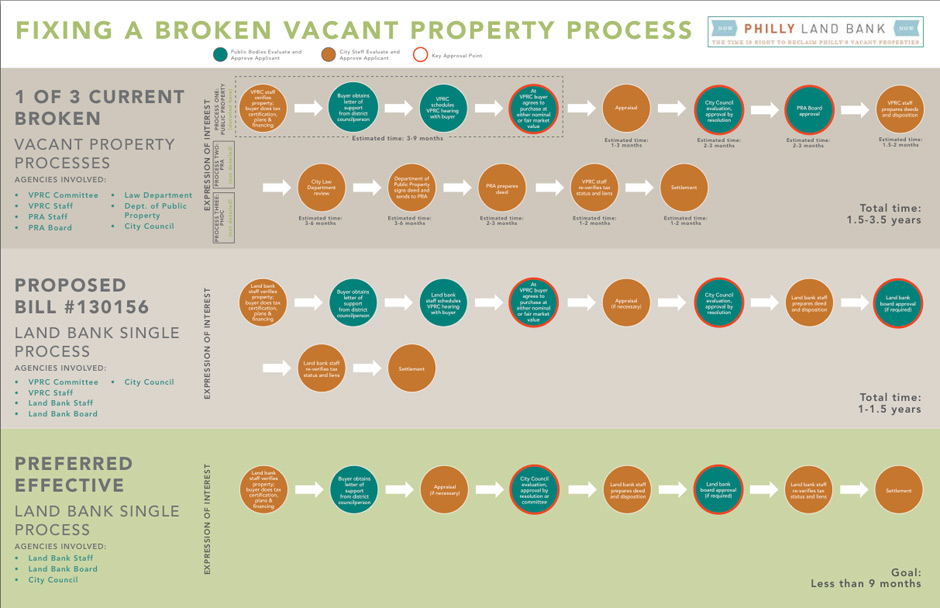What Philly Should Have Learned From Baltimore About Land Banks
 After two years of crafting a land bank bill that would streamline the messy, maddening process of buying land from the city, Councilwoman Maria Quiñones-Sanchez’s legislative magnum opus finally passed a first-reading last week, but far less triumphantly than many would have liked. In the 11th hour, Sanchez capitulated to an amendment by Council President Darrell Clarke that would effectively retain the stifling councilmanic control over the sale of land. (The bill has since been passed.)
After two years of crafting a land bank bill that would streamline the messy, maddening process of buying land from the city, Councilwoman Maria Quiñones-Sanchez’s legislative magnum opus finally passed a first-reading last week, but far less triumphantly than many would have liked. In the 11th hour, Sanchez capitulated to an amendment by Council President Darrell Clarke that would effectively retain the stifling councilmanic control over the sale of land. (The bill has since been passed.)
The complexity of land issues in Philadelphia can be (partially) explained thus: There are 40,000 vacant parcels of land and around 9,000 of them are owned by the city. The land owned by the city is trapped in a governmental hall of mirrors run by multiple agencies and whose disposition requires, among many other things, a resolution by council every time a parcel is transferred. The transfer takes ages to actually go from city to buyer, and the city is loathe to acquire any of the 40,000 vacant properties because it doesn’t want to pile additional cost and liabilities onto the backlog.
 By no means does Clarke’s amendment destroy the land bank. But the amendment, which retains a controversial Vacant Property Review Committee [VPRC] to approve all land sales, is still an enormous blow to Sanchez. The VPRC effectively functions as the first arbiter in the land sale process. If a buyer expresses interest in a property, the VPRC decides whether that property will actually move forward in a chain of events to eventually get the land to the buyer. The big kicker for Clarke is that he gets to choose the chair of the VPRC, and that chair decides what land is even on the agenda for the VPRC’s discussion. In other words, Clarke has an enormous amount of control in a body that was supposed to minimize this very type of councilmanic control.
By no means does Clarke’s amendment destroy the land bank. But the amendment, which retains a controversial Vacant Property Review Committee [VPRC] to approve all land sales, is still an enormous blow to Sanchez. The VPRC effectively functions as the first arbiter in the land sale process. If a buyer expresses interest in a property, the VPRC decides whether that property will actually move forward in a chain of events to eventually get the land to the buyer. The big kicker for Clarke is that he gets to choose the chair of the VPRC, and that chair decides what land is even on the agenda for the VPRC’s discussion. In other words, Clarke has an enormous amount of control in a body that was supposed to minimize this very type of councilmanic control.
“When the governing body elects to maintain control over acquisition and disposition on a parcel-by-parcel basis [as the VPRC does], it tends to undercut dramatically the effectiveness of a land bank,” says Frank Alexander, founder of the Center for Community Progress which helps cities and states draft land bank legislation. Alexander said he had not read the version of the bill as read by council on Thursday, but said the way the bill was originally written with the VPRC “gave me so much concern. Now if that’s still present that city council will review every acquisition and every disposition, it certainly means the effectiveness of the land bank will be diminished.”
In the scope of land bank history, pushback by power-hungry city councils is something of a norm. Cleveland’s original land bank was so saddled with councilmanic control that its home county of Cuyahoga created its own land bank that has since been referred to as a model in the country for efficiently acquiring, renovating and selling off land in a county that was hard hit by blight-inducing foreclosures. Detroit had a functionless land bank for a decade until it was reconfigured in 2010.
And in Baltimore, the similarities to Philadelphia are uncanny.
In 2009, then Baltimore Mayor Sheila Dixon found herself up against a Clarke-like Stephanie Rawlings-Blake, then council president and mayoral hopeful (she eventually became mayor). Dixon had worked on the design of a land bank since the early days of her mayoralty in 2007. She tried to find takers in council to introduce it on her behalf.
The sticking point for Rawlings-Blake was that Baltimore’s land bank would sell land without approval of the Board of Estimates, basically Baltimore’s VPRC, that requires council approval on all city transactions over $5,000. Rawlings-Blake said that the Board of Estimates retained “transparency” for the land disposition process — one of Clarke’s favorite buzzwords and one that was used frequently Thursday by public commenters who may or may not have been induced to appear by Clarke himself.
Unlike Sanchez, who as a councilperson can introduce bills herself, Dixon never found someone to spearhead the movement in Baltimore, in no small part because her efforts for land reform were by overshadowed by an indictment for stealing gift cards. She resigned before the bill was ever introduced.
“It was more about politics and power,” Dixon tells me on the phone. “The only thing I found interesting is we went through a two-year process involving [council] on the board and meetings and the study and everything. And we went through all this hard work and then came up with all this resistance.”
“There was resistance by some council members who felt they wouldn’t have the same prerogative over their districts,” says Julie Day, deputy commissioner of resources at Baltimore Housing.
Baltimore Housing now administers the Vacants-to-Value program, a patchwork of policies that together form a kind of ad hoc land bank. The program seems at best slightly better than what was in place before it (which was similar to what Philly has now) and at worst little more than the illusion of expediency. The Vacants-to-Value initiative includes the ability for a developer to target a blighted property, have it yanked out of control of the owner and placed into a receivership by the court where it is ultimately handed over to a buyer. Between the starting and ending points is a lot of confusion, money and uncertainty. A similar legal option called a conservatorship exists in Philadelphia and while it can be useful, it is fraught with inefficiency.
In other words, Baltimore ended up with not so much a land bank as the idea of a land bank, steps that were easily branded as reforms but never required city council to actually relinquish the obsessive control over territory that is required to actually change the use of land in a city. Will Philadelphia end up with something similar?
“Philadelphia’s council could elect to have no oversight and let the board of directors [which sets general policy instead of approving every single individual sale] handle things,” says Alexander. Given that Clarke just fought tooth-and-nail to prevent that from happening, an about face doesn’t seem forthcoming.
Follow @asthompson on Twitter.

This flowchart, provided by Councilwoman Maria Quiñones-Sanchez’s office, describes Philadelphia’s current process (top), Council President Darrell Clarke’s proposal (middle) and Quiñones-Sanchez’s Land Bank proposal (bottom).


